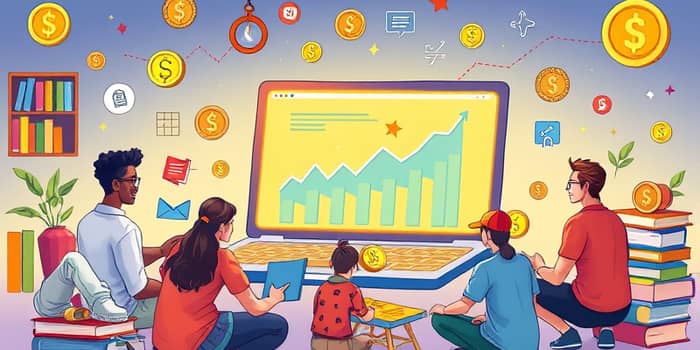Unlock the power of financial knowledge and gain confidence in money management without opening your wallet.
Why Free Financial Literacy Courses Are Essential
In today’s rapidly changing economy, understanding how to manage money effectively is no longer a luxury—it’s a necessity. Financial literacy empowers individuals to make informed decisions, avoid costly mistakes, and plan your financial future with clarity.
Whether you’re a high school student choosing your first bank account, a college graduate tackling student loans, or a professional aiming to optimize your investments, comprehensive financial education is the foundation of long-term success.
By accessing quality resources at no cost, learners can bridge the gap between intention and action. From budgeting basics to retirement strategies, these courses offer practical step-by-step guidance that transforms complex concepts into everyday skills.
Top Providers and Their Offerings
Several reputable platforms deliver free financial education, each tailored to different needs, learning styles, and age groups. Explore the following providers to find the program that aligns with your goals:
- Khan Academy: Self-paced, comprehensive modules covering budgeting, loans, insurance, retirement, and fraud prevention.
- InCharge Debt Solutions: Short, focused lessons on debt control, savings success, credit improvement, and budgeting strategies.
- EVERFI: Interactive digital lessons for high school students, available in English and Spanish, spanning basic consumer skills to insurance fundamentals.
- Coursera: University-backed courses on financial planning, investments, and career-ready money management, with flexible schedules.
What You Will Learn in These Courses
Free financial literacy programs cover a broad spectrum of topics designed to build a strong money-management foundation and foster lifelong financial confidence. Key learning areas include:
- Budgeting and Saving: Crafting realistic budgets, setting SMART goals, and build an emergency fund for unexpected expenses.
- Managing Debt: Understanding loan types, interest calculations, repayment strategies, and bankruptcy basics.
- Credit Fundamentals: How credit scores are calculated, tips for improvement, and the impact of credit on your financial health.
- Investing and Retirement Planning: Risk vs. return analysis, retirement accounts (401(k), IRAs), diversification, and long-term growth strategies.
- Insurance Essentials: Types of coverage (health, life, disability, property, auto), risk management, and estate planning considerations.
- Taxes and Income: Tax system mechanics, filing basics, pay stub interpretation, and strategies to maximize after-tax income.
- Consumer Protection: Recognizing scams, safeguarding personal information, and understanding consumer rights and contracts.
- Digital Finance and Practical Skills: Online banking, digital wallets, cryptocurrency basics, and decisions around renting or purchasing assets.
Benefits of Taking Free Financial Literacy Courses
Enrolling in no-cost financial education programs delivers transformative benefits that extend far beyond the digital classroom. Participants often report:
- Empowerment and sustained confidence in making money-related choices.
- Reduced stress through clear, actionable plans for debt repayment and savings growth.
- Improved long-term financial well-being and preparedness for life’s milestones.
- Enhanced career prospects and personal development via certified learning paths.
Moreover, these courses foster a sense of community. Many providers include forums, peer discussions, and instructor feedback to reinforce learning and encourage accountability.
Getting Started and Making the Most of Your Learning
Embarking on your financial education journey is as simple as choosing a platform and setting aside regular study time. To maximize your progress, consider the following steps:
1. Define clear objectives: Identify short-term goals like reducing credit card balances and long-term targets such as funding retirement accounts.
2. Create a learning schedule: Allocate consistent weekly slots for coursework, quizzes, and review sessions to build momentum.
3. Engage with interactive resources: Take advantage of exercises, interactive quizzes and printable materials, and discussion boards to deepen understanding.
4. Apply concepts in real life: Implement budgeting templates, test savings strategies, and monitor your credit score to reinforce theory with practice.
5. Track your achievements: Record milestones, celebrate small wins, and adjust your plan as you advance through modules to stay motivated.
Conclusion
Financial literacy is a lifelong pursuit that begins with a single click. By leveraging these free online courses, you can take control of your financial journey, make informed decisions, and cultivate habits that lead to stability and growth.
Embrace the opportunity to learn at your own pace, without cost barriers, and join a global community committed to smarter money management. Start today, and watch your financial confidence flourish as you transform knowledge into action.
References
- https://www.khanacademy.org/college-careers-more/financial-literacy
- https://www.coursera.org/courses?query=financial+literacy
- https://www.cashstore.com/blog/free-personal-finance-courses
- https://www.capitalone.com/learn-grow/money-management/khan-academy-financial-literacy-course/
- https://www.incharge.org/financial-literacy/courses/
- https://www.cde.ca.gov/ci/cr/cf/personalfinance.asp
- https://www.incharge.org/financial-literacy/
- https://everfi.com/courses/k-12/financial-literacy-high-school/










